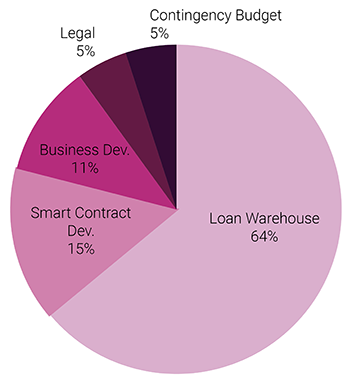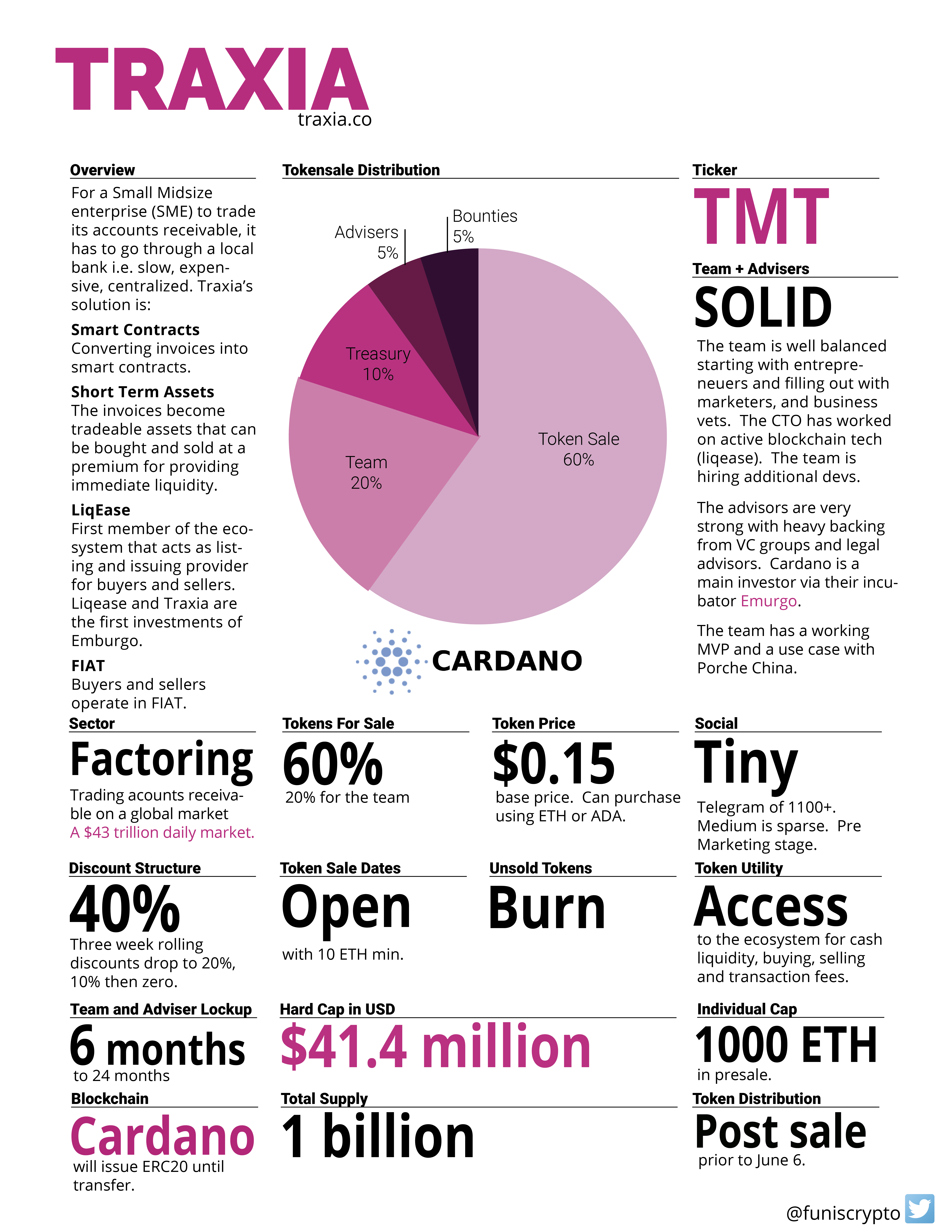(What is Traxia')
Traxia is a Cardano based project that will disrupt trade finance. Traxia allows small midsize enterprises (SME) to trade accounts receivable, at a premium, to receive instant liquidity.
(What does it actually do')
In simple terms Traxia will allow SMEs to sell invoices (accounts receivable) to investors. This will provide liquidity to businesses by making accounts receivable into short term tradeable assets thus shortening the billing cycle.
An example of this would be:
- A clothing manufacturer signs a deal with Nordstroms to deliver 1000 shirts. Nordstrom will pay the importer upon delivery of the shirts.
- Manufacturer starts on the shirt project and estimates completion in 60 days. The manufacturer must pay employees and purchase supplies prior to payment.
- The manufacturer uses Traxia to "sell" their Nordstroms invoice for 90% of the value.
- The manufacturer receives payment from Traxia for the invoices.
- 60 days later the clothing shipment arrives at Nordstroms and the investors receive payment from Nordstroms directly.
In this example the manufacturer received 90% of their payment 60 days in advance. This increased liquidity allows them to make additional deals, create more merchandise and grow their business faster.
(This sounds familiar')
Factoring is a financial transaction and a type of debtor finance in which a business sells its accounts receivable (i.e., invoices) to a third party (called a factor) at a discount. This is big business and its a common occurrence daily.
Traxia wants to make it easier for SMEs to get access to factoring without relying on banks. They want a small piece of the $43 trillion USD daily accounts receivable market.
(How will Traxia do this')
The Traxia ecosystem is composed of multiple players and components. The main players are:
Sellers - Upload their invoices to sell their accounts receivable.
=>Buyers - The party purchasing product from the seller. They have to confirm (using a private key) that the invoice is correct and agree to pay it. The credit rating of the buyer affects the rate the seller receives for their invoice.
=>Issuing Providers* - Converts the invoice into a smart contract and makes it into a tradeable asset. They are the liaison to the blockchain and LiqEase will initially provide this service.
=>Liquidity Providers..! Fund or institutional investor that initially purchases the asset before reselling it on the exchange. Gets paid the spread.
=>Loan Warehouse..! A Traxia owned facility (digital) that will initially act as a liquidity provider.
=>Listing Provider..! The exchange where the assets are listed. Connects liquidity providers with investors.
=>Investors..!Individuals that visit the marketplace to invest and trade parts or bundles of invoices (that are now digital assets) with the expectation of achieving a profit in such trades.
Let's look at the initial example of the shirt manufacturer:

The seller (manufacturer) and buyer (Nordstroms) sign the deal for 1000 shirts. The seller wants to use Traxia so they convert their accounts receivable to a tradeable asset via LiqEase and Traxia. In order to do this, Nordstroms verifies and authorizes the transaction using their private key.
The invoice is converted into a smart contract (digital token) by the issuing provider (LiqEase) and listed onto a marketplace for sale by a listing provider (LiqEase). At this point individual investors can purchase the asset (invoice) at a premium providing instant liquidity to the seller.
When the contract is fulfilled the buyer will purchase the digital token (smart contract) from the investors and the investors will take profit.
#Receives commissions :
(What is LiqEase')
Traxia is composed of two entities, the non-profit Traxia Foundation and the for profit business LiqEase. LiqEase is building the tech behind the platform and will act as the initial liquidity and listing provider in the ecosystem.
When reviewing Traxia documenation and websites the names sometimes appear interchangeable as team members and concepts float between each entity.
(Tell me about the token')
The token, TMT, is a utility token that is required as payment by issuing providers for adding new invoices to the system. This system allows for mass adoption of the platform because both buyers and sellers can continue to operate using FIAT.
(What about the team')
The team is well balanced starting with entrepreneurs and filling out with marketers, and business vets. The CTO has worked on active blockchain tech (liqease). The team is currently hiring additional devs.
The advisors are very strong with heavy backing from VC groups and legal advisors. Cardano is a main investor via their incubator Emurgo and Darren Camas, a senior adviser, is both an investor and adviser in this project.
The team has a working MVP and a use case with Porche China.
Team (Additional team and advisers on Traxia website)
Florian Pfutze - CEO/Co-Founder
Florian Zeim - Co-Founder and Product Development Lead
Jean Michel Lied Lied - CTO
Bruno Botelho - CMO
Sebastien Cheng - Business Development Executive
Advisors:
William Bao Bean - General Partner at SOSV
Darren Camas - Emburgo
Zennon Kapron - Former Intel and Citibank
(What's up with the ICO')
At this time the ICO includes four presale rounds offering 40% of the total token supply for sale. The base price of the token is $0.15 and can be purchased with ETH or ADA.

The first round of presale is currently open and is offering 22% of the total supply at the maximum discount of 40%. This discount is available until March 18th and requires a minimum contribution of 10 ETH and limits individuals to a max 1000 ETH.
The second round of the presale runs from March 9th to April 9th and offers a 20% discount. The minimum contribution is lowered to .1 ETH (or ADA equivalent). This round is offering 18% of the total supply for sale.
It appears that the third and fourth rounds will sell any remaining tokens from the first two rounds at a 10% discount followed by no discount. If needed, round 4 would end on June 2nd. The max individual cap is lifted for round 4.
The hardcap of the token sale is $41.4 million and there is no soft cap.
According to the whitepaper a total of 60% of the total TMT tokens will eventually be sold to the public. According to the CMO Bruno Botelho the additional 20% will be sold to create additional capital if needed and they are unlikely to be sold within the first 3 years.
Unsold tokens will be burned.
Tokens will be distributed at the close of the crowdsale, either when hardcap is reached or by June 2.
Team member, early investors, advisers and strategic partners will have 60% of their tokens locked for 12 months and the remaining 40% locked for 24 months. The treasury fund will also be locked for two years.
(Marketcap & Token Supply')
The project at hardcap would have a marketcap of approximately $41.4 million (400 million TMT) if no additional tokens are released at the time. In the current ICO environment the calculated marketcap is on the high side.

The high amount of funding is required to properly fund the loan warehouse that Traxia is implementing. See the fund allocation on the left.
The loan warehouse will allow Traxia to purchase accounts receivable and hold them until they are repurchased by a buyer. In the intial stages of the project the warehouse will play an important role in matchmaking and the prevention of bottlenecks for the ecosystem.
The total token supply is 1 billion TMT.
(Partnerships')
The project has yet to announce many partnerships but their technological partners are Cardano and Emurgo. Emurgo will use Traxia as a test case for migrating platforms from Ethereum to Cardano.
Traxia has also partnered with creditsafe.com which is a credit rating service for companies.
Although not an official partner, Traxia has completed a use case (MVP) using Porsche China which is detailed in the whitepaper.
(Social & Hype')
The TMT Telegram group has 1100+ members and reflects that this project is in the early stages of marketing. The Telegram is increasing in activity and team members including the CEO Tobias and CMO Bruno both appear to answer questions.
This crowdsale is not highly hyped at this time but it is expected to increase as the token sale builds momentum. This is the first project to build on Cardano and is backed by Emurgo, both of which should help to increase interest.
(Overall')
The accounts receivable industry is a $43 trillion/day industry. The team is valuing their project at 0.35% of this market (or $150 million). This is a project that can utilize blockchain to solve a real world problem and the ability for buyers and sellers to use FIAT will help with adoption.
This project is the first to build on Cardano and will act as the test case for Emurgo and their migration services. Emurgo (Cardano investment incubator) is also the lead investor in the seed round showing Cardano's confidence in the project.
We recommend doing additional research if this project interests you.
For more information visit:

This post is not investment advice. It is an overview of the Traxia tokensale metrics.
Author: Crypto Channel: ( https://bitcointalk.org/index.php?action=profile;u=1153401 )
Mytherwallet: 0xf02df1350820ecc4C58BF067739900A50722D5Ca
